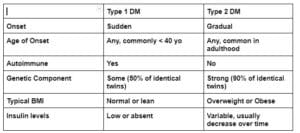There are two main types of diabetes, type 1 and type 2. Formally, we refer to diabetes as diabetes mellitus (DM). The name is derived from the Greek word, diabetes, meaning to siphon or draw away liquid, and the Latin word, mellitus, meaning sweet. When diabetes was first recognized almost 700 years ago, it was described as a disease that caused people to urinate frequently and waste away. Frequent urination is still one of the first symptoms noted with new onset diabetes.
Usually, the sugar (glucose) in the blood is tightly regulated by a hormone called insulin. In people with diabetes, there is not enough insulin to push sugar into the cells, where it can be used for energy. As a result, the blood sugar becomes elevated and the kidneys have to filter an increased load of sugar out of the body via the urine. Although scientists didn’t have a laboratory test to check for sugar in the urine until the 1800s, tasting the urine for sweetness was a crude early method of diagnosis.
Although both type 1 and type 2 diabetes are defined by high blood sugar levels, the underlying cause of the high blood sugar is quite different. In type 1 diabetes, the insulin-producing beta cells in the pancreas are incorrectly identified as targets by the immune system. The immune system attacks the beta cells, the beta cells lose the ability to produce insulin, and the blood sugar becomes elevated. Because there is an absolute deficiency of insulin, people with type 1 diabetes require lifelong treatment with insulin.
In type 2 diabetes, on the other hand, there is not a single mechanism that has been identified as the underlying cause of elevated blood sugars. Rather, the cause is multifactorial, with both genetic and environmental factors contributing. The genetic component of type 2 diabetes is strong; almost 40% of individuals with type 2 diabetes have at least one parent with diabetes. Environmental factors, such as overweight/obesity, diets high in processed foods, and sedentary lifestyles have become increasingly prevalent in industrialized countries and have led to a steep rise in type 2 diabetes. Together, these genetic and environmental factors have been linked to the development of 1) impaired insulin secretion 2) resistance of the cells to insulin, and 3) ultimately type 2 diabetes. Usually, people with type 2 diabetes continue to secrete insulin for years, thus they can (at least initially) be treated with medications that work to either increase insulin from the pancreas or increase the cells’ ability to use the insulin already being produced.
Type 2 diabetes is the most common type of diabetes by far, accounting for 90-95 % of cases in the United States. It is estimated that about one out of every ten Americans has diabetes and, of those, 20% are unaware they have it.
If you are experiencing any symptoms of diabetes, such as frequent urination, blurry vision, numbness or tingling in your hands or feet, or unexplained weight loss, please check in with your health care provider to see if a diabetes screening test is indicated.
